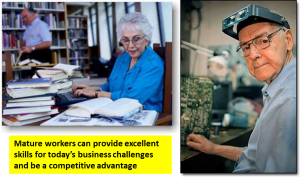This blog concludes my three part series on the diversity of aging that I began in late June. In part one (link), I provided a general introduction to the topic of aging and shared some recent personal experiences that motivated me to write this series of blogs. In part 2 (link), I explored the intersection of LGBT (Lesbian, Gay, Bisexual, Transgender) and Aging Diversity.
In this final blog I will focus on two key areas for companies and organizations to consider in terms of aging or mature workers:

1) Are the talents and expertise of older employees being fully leveraged?
2) Are companies building the required pipeline of new leaders as older employees retire?
In terms of fully leveraging the talents and expertise of older, experienced employees, here are some ideas:
• Now with four generations of workers on the job, are you providing solid training so that the diverse groups can work together in a respectful and productive way?
• Are you introducing innovative programs for mature employees such as part time work as a bridge to full retirement?
AARP (An Ally for Real Possibilities) provides a wide range of resources (link) for the experienced worker.
The current experienced workforce is now one of the largest segments in the USA due to the increased birthrate from 1945 – 1964. This generation, often referred to as “baby boomers” are retiring in increasing rates and many companies are experiencing a critical talent shortage. Ideas for addressing the need to grow a leadership talent pipeline include:
• Do you have robust programs in place to engage your younger employees in meaningful career development and growth? Total Engagement Consulting by Kimer offers an innovative program using career maps of successful professionals to provide ideas and guidance to all employees. You can read this recent online article about this unique process.
• Are you taking full advantage of senior employees by asking them to mentor junior employees? This can be a great way to foster institutional knowledge transfer and to make the senior employees feel good about their work and accomplishments.
• Do your diversity programs include leadership elements so that your future leadership pipeline is as broad as possible and includes a full mix of gender, race, LGBT and other aspects of diversity?
Proper treatment and leveraging of the aging worker population can indeed be built into a business advantage instead of becoming a major issue!
